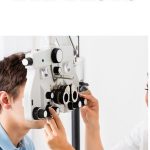Sooner or later, our vision will fail us. It is expected that as we age, there will be vision changes. The most common vision problem as we age is the eye’s inability to focus, called Presbyopia. At this point, you are struggling with your newspaper, mobile phone, or restaurant menu. You find yourself needing to further it away from your eyes to read it.
When we find ourselves at this junction, and most people will, you might need bifocal eyeglasses. All thanks to Benjamin Franklin, who devised the bifocal eyeglasses when he combined half of his reading and distance glasses to arrive at what we call bifocal glasses today. However, we are still determining where Benjamin Franklin placed the line on his improvised bifocal glasses.
At this point in history, the question most people often ask when visiting their optician for their bifocal glasses is the best place to place the line. The blog post will intend to address this concern and question once and for all.

What Are The Problems Associated With Bifocal Eyeglasses?
Outside of the best place to place the bifocal line, it is also essential to state that there are other problems that bifocal wearers might need help with. However, this will be dealt with alongside the question of where should bifocal line be, as the line cannot be too high or too low, but where is most appropriate?
Before getting into that, here are a couple of problems that is peculiar to bifocal eyeglasses;
Wrong Placement of The Bifocal Lines
There’s no rule of thumb for the best place to have the lines of a bifocal. However, it’s important that you don’t get the placement wrong. The best place the lines could be will be at the same level with the bottom eyelid.
Once the bifocal line is too high, there will be an issue with getting adequate distance vision.
Struggling to Adjust To Bifocal Glasses
You cannot get used to bifocal glasses overnight, and it will take a while. So initially, you may see yourself grappling with knowing the right section to look for what.
If you give yourself time to adjust and adapt to the glasses, it’ll be your best decision for your vision.
Changes in The Way You Judge Distance and Depth
As you look at your bifocal glasses, you will need to relearn how to determine distance and depth, especially when you look through the bottom of the glasses. Else, you may trip or fall on a stairs or in a new environment.
Other problems could be blurry vision, balance problems, nausea, and headaches. All of these will disappear over time.
Related Posts
How To Determine Where The Bifocal Line Should Be
There’s no one size fits all approach to pinpointing where the bifocal line should be. However, according to WebMD, the line should be within 1.5mm above or below the lower eyelashes and the eyelid.
If the line is lower, you will be reducing the reading area, and the wear will struggle and need always to tilt their head to look through the reading area. This could make wearing bifocal eyeglasses frustrating, demanding, and painful.
It is also important to settle for a frame before lining the bifocal eyeglasses. You will have to try out the frame to ascertain that it has enough vertical height to be able to position the bifocal line. This is because the face of everyone is different, and the frame sits differently on every face.
There will always be a difference in ear location, nose location, nose width, and frame height; all of these determine where a frame will sit on the face. Where the frame sits is the ultimate determinant of the best positioning for the bifocal line.
There may be a need for the glass retailer to forward you the frame in order for you to be able to mark out the best position for the bifocal line.
It is also essential to state that in your choice of frames, avoid those with sweat bars as they ride too low and are not best for the bifocal lines. Instead, look for frames with a solid nose piece, or else you may see the bifocal segment positioned too low. Most importantly, be on the lookout for a frame with at least 24mm vertical height.
Final Thoughts
It doesn’t matter how long you’ve been wearing prescription glasses, but bifocal glasses are in a class of their own. This is why you must understand bifocal glasses before you start wearing one.
As for the best place to place the line, you’ll need to rely on the expertise and experience of your optician. The optician will have to subject you to a thorough eye examination and be able to write a crystal-clear prescription for your bifocal glasses.




